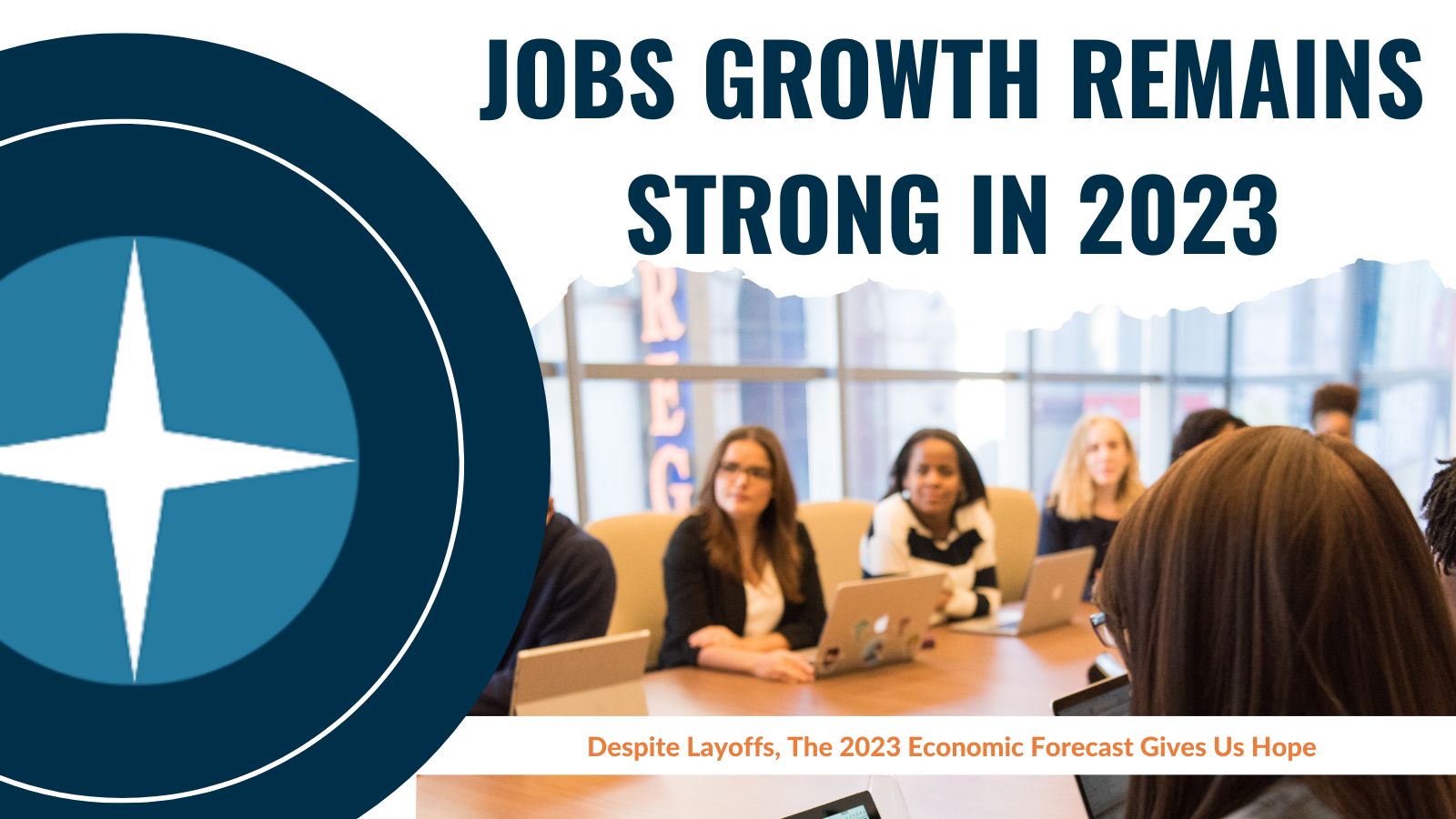
If you’ve scrolled through LinkedIn or turned on the news lately, you’ve likely been inundated with layoff news. While the technology sector accounted for 41% of the layoffs, retailers and financial firms reduced their workforce, as well. Coupled with the Federal Reserve’s interest-rate increases and talk of a possible recession, it’s hard not to feel pessimistic about the year ahead.
A Tight Labor Market Continues with Record Unemployment
The labor market might be more resilient than you think. New data from the Labor Department shows that the U.S. labor market continues to be tight—job openings in December surged to a 5-month high with over 11 million available positions compared to 10.4 million in November. There are 1.9 openings for every job seeker.
January’s Jobs Report exceeded expectations nearly three-fold. The U.S. economy added 517,000 jobs in January, ahead of the expected 185,000. This beats the 504,000 jobs added in January 2022 and is close to the 520,000 added in January 2021. In addition, unemployment fell from 3.5% to 3.4% (a 53-year low).
Low Jobless Claims Rate
The cutbacks that dominate our newsfeeds are not widespread. The U.S. weekly jobless claims are at the lowest level since April 2022. While economists polled by Reuters forecast 200,000 jobless claims for the week ending January 28th, 183,000 claims were reported. This is the third straight weekly decline in applications. A low claims rate indicates a continued tight labor market.
Sectors that experienced an increase in hiring over December included utilities, government administration, hospitals and healthcare, administrative & support services, construction, transportation, logistics, supply chain, and storage. The largest hiring declines were experienced in real estate & equipment rental services, retail, farming, and ranching & forestry.
Manufacturing Contracts, But Maintains Workers
While U.S. manufacturing contracted in January due to high interest rates affecting demand for goods, they’re holding on to their workers for now. Manufacturers are not planning on substantially reducing head counts and are positive about the second half of 2023, according to a new Institute for Supply Management report.
Wage Growth Holds Steady
Wage growth held steady, rising an annual 7.3% (unchanged from December). 4.1 million Americans decided to leave their jobs voluntarily and workers who switched jobs saw a median wage increase of 15.4%. The number of workers quitting their job reached a record high at the end of 2021.
Slight Improvement in Labor Participation Rate
While many workers switched to better job opportunities, others may have dropped out of the workforce altogether—the labor market has decreased by three million since the beginning of the Pandemic. A declining labor participation rate contributes to a further talent shortage; there are simply not enough job seekers to fill open positions. Good news though: January’s job report does show a slight rise in the labor participation rate from 62.4% to 62.3%, meaning there is a larger pool of applicants from which employers can choose.
A Talent Shortage Remains
According to the Harvard Business Review, we’re unlikely to experience a redo of the 2008 employer’s market. There’s a true talent shortage, and it’s a worker’s market. A recent report from the National Federation of Independent Businesses stated that 90% of small businesses trying to hire reported few or no qualified applicants for their open positions. With the tightest labor market in more than 20 years, good talent remains hard to find and retain.
What Can We Expect in 2023?
 It may be a bumpy ride. High inflation, the Federal Reserve’s interest rate hikes, and a potential mild recession may curb consumer spending and business hiring. How much will this impact the next hiring report? We will have to wait and see.
It may be a bumpy ride. High inflation, the Federal Reserve’s interest rate hikes, and a potential mild recession may curb consumer spending and business hiring. How much will this impact the next hiring report? We will have to wait and see.
It appears that the job market will remain resilient and any economic downturn in 2023 will be shallow and short. The economy maintains momentum, and economic conditions will likely improve later this year as inflation levels out. While we can expect moderate cooling off in the labor market as interest rates and inflation remain high, we’re headed in a positive direction.
If you’re struggling to fill your open positions, be sure to check out our Recruitment Process Outsourcing (RPO) services. A challenging economy makes it the ideal time to utilize an RPO provider, as they have dedicated recruiters, tools, and technology you may not have internally. We can help you prepare for the hiring challenges of tomorrow by building your talent pipeline today.
Archives
- January 2026
- December 2025
- November 2025
- October 2025
- September 2025
- August 2025
- July 2025
- June 2025
- May 2025
- April 2025
- March 2025
- February 2025
- October 2024
- May 2024
- March 2024
- February 2024
- January 2024
- December 2023
- November 2023
- October 2023
- September 2023
- August 2023
- July 2023
- June 2023
- May 2023
- April 2023
- March 2023
- February 2023
- January 2023
- December 2022
- November 2022
- October 2022
- September 2022
- August 2022
- July 2022
- June 2022
- May 2022
- April 2022
- March 2022
- February 2022
- January 2022
- December 2021
- November 2021
- October 2021
- September 2021
- August 2021
- July 2021
- June 2021
- May 2021
- April 2021
- March 2021
- February 2021
- January 2021
- December 2020
- November 2020
- October 2020
- September 2020
- August 2020
- July 2020
- June 2020
- May 2020
- April 2020
- March 2020
- February 2020
- January 2020
- December 2019
- November 2019
- October 2019
- September 2019
- August 2019
- July 2019
- June 2019
- May 2019
- April 2019
- March 2019
- February 2019
- January 2019
- December 2018
- November 2018
- October 2018
- September 2018
- August 2018
- July 2018
- June 2018
- May 2018
- April 2018
- March 2018
- February 2018
- January 2018
- December 2017
- November 2017
- October 2017
- September 2017
- August 2017
- July 2017
- June 2017
- May 2017
- March 2017
- February 2017
- January 2017
 RSS Feed
RSS Feed




















